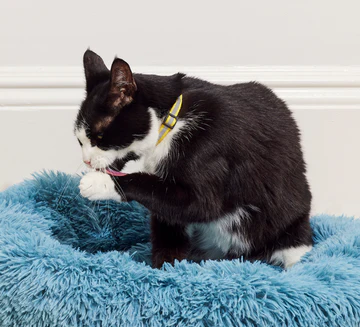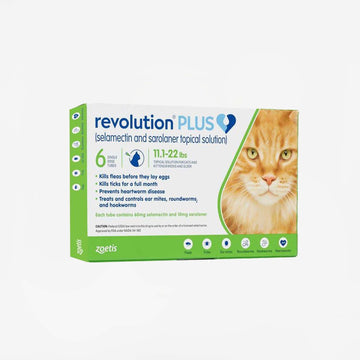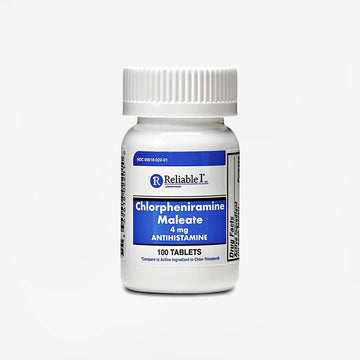Treat your cat's skin irritation, rashes and inflammation online
Skip the trip and see one of our online vets to get a diagnosis and prescription. Plans start at $11/mo.

- Unlimited vet visits and follow-ups
- Prescriptions delivered free to you
- 100% licensed veterinarians

Causes and treatment for cat skin irritation
Learn what causes cat skin issues and what to do about it.


Infections
Infections
If your cat contracts an infection, this can potentially lead to skin irritation. Several types of bacterial and fungal infections (like ringworm) can cause symptoms such as extreme itching, scaling, bald spots, redness, swelling, bumps, and fluid discharge.
Parasites
Parasites
Parasites are one of the most common causes of skin issues in cats. Mites, fleas, and other parasites can cause inflammation, itchy skin, sores, scabs, hair loss, and more. The skin condition called mange is caused by mites. Many parasite infestations can be prevented by using a monthly flea and tick medication for cats.
Allergies
Allergies
Allergies often produce skin irritation in cats. Food sensitivities, environmental allergens, insect bites, and seasonal allergies can all lead to symptoms like skin inflammation, itching, redness, rash, and hair loss. There are several medications available through a Dutch vet to help your cat’s allergies.
Acne
Acne
Notice what looks like a rash or blackheads on your cat’s chin? This could be feline acne (yep, they get zits too). Untreated acne can cause itchiness and infections. Fortunately, it’s easily treated with medication.
Treatments for cat skin issues
Treatments for cat skin issues
The treatment for cat skin issues will depend on the root cause of the problem. The most effective treatment method will address the underlying medical condition causing the irritation, such as fleas, allergies, or an infection. With Dutch, you can quickly meet with a top-rated vet who can help identify and treat your cat’s skin issues.
How Dutch works
-
Pick a plan and become a member
-
Schedule a video call with a licensed vet
-
Order the prescriptions the vet recommends
Frequently asked questions
What can I use Dutch for?
What can I use Dutch for?
With Dutch, you’re never alone when it comes to your pet’s health. Whether your pet needs care or you just have a question, our compassionate and knowledgeable vets are always happy to help.
Here are some ways you can use Dutch:
- Care & prescriptions for over 150 issues
- Behavioral health, nutrition, and exercise advice
- Puppy, kitten, and new pet parent advice
- Preventive care plans
- Night and weekend vet care
- Second opinions & follow-up care after in-person visits
- Advice on whether you need to go to the ER or urgent care
- Vet care when you’re traveling
- Easy prescription refills
- Longevity treatment plans
- Answers to non-urgent questions
What is a visit with Dutch like?
What is a visit with Dutch like?
When booking a video call with a vet, you'll be asked a few questions about your pet’s health issue. Depending on the issue, you may also be asked to fill out a longer questionnaire about their symptoms and share photographs of them so our veterinarians can better understand what’s going on. You’ll then pick an appointment time that works best for you.
During your video call, one of our licensed veterinarians will talk to you about the symptoms your pet is experiencing, ask you questions, review your pet’s medical history if you’ve provided it, and answer any questions you have. The vet will ask to see your pet and their environment. And they may ask you to perform some simple checks on them if needed.
After your video call, the vet will send you a message with a custom treatment plan to help your pet feel better, including a link to buy any recommended prescription or over-the-counter medications. Place your order and we’ll ship it free.
How do I know if you can treat my pet?
How do I know if you can treat my pet?
Our vets can provide care and prescriptions for more than 150 issues — and over 90% of cases can be treated virtually.
The vet can diagnose your pet based on your description of their symptoms, their medical history, seeing them during your video call, and, if needed, through uploaded photos and videos. They may ask you to do a few simple checks during the call. We also offer a number of at-home lab test kits for dogs and cats.
The health and safety of pets is our top priority. In the rare case that a vet determines a pet needs to go to a local clinic, they’ll provide a referral and offer advice on how to care for them until they can be seen.
Some things that require in-person care include emergencies, wounds that need stitches, and issues that require blood work, imaging (X-rays or ultrasounds), or surgery.
Our vets are always available for second opinions and follow-up care after in-person vet visits — so you don’t have to navigate health issues alone.
How much will it cost for Dutch to treat my pet?
How much will it cost for Dutch to treat my pet?
Our memberships are designed to make your pet’s care as easy and affordable as possible. Here’s how your costs will break down:
Membership: You can choose to pay the total price upfront or in 4 installments. All memberships include unlimited care for up to 5 pets at no extra cost.
Vet calls and messaging: No cost — video chat and message with vets as often as you need for free.
Medication: The price will vary depending on your pet’s needs. To keep your costs down, we offer a price-match guarantee, free standard shipping, $25 off your first product order, and 20% off your first flea & tick order.



